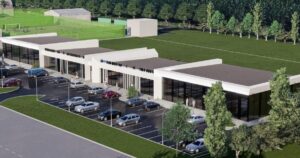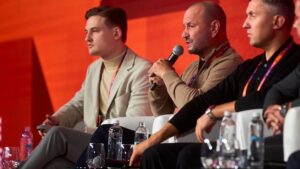
Approximately $3.5 million has been invested in the modernization of the Bessarabsky Market in the capital and the launch of the “Bessarabka. Food Market” project, according to project manager Natalia Dzhuylay.
“The estimated investment in the modernization is about UAH 150 million (approximately $3.5 million at the exchange rate at the time of calculation). More than half of this amount was raised in the form of a loan, the rest — from the project participants’ own funds,” she told the media outlet “Reve ta stogne restaurator” (The Restorer Roars and Moans).
She noted that this project is changing the essence and purpose of the Bessarabsky Market: traders who have worked here for decades are returning to their places and continuing to work in the renovated, but essentially unchanged, shopping arcades.
According to her, the main principle of the food hall concept is that there should be no duplication of formats and menus, and each corner should occupy a unique niche. Contracts with residents are concluded for one year.
“In case of failure to meet the specified financial indicators, we reserve the right to replace the corner. But it is obvious that failure to meet KPIs is primarily unprofitable for the resident itself, as it means a lack of sufficient revenue and traffic. We are interested in each corner working effectively, so in case of a decline, we will analyze the reasons and look for ways to improve,” Dzhuay said.
The project’s Instagram page does not have an opening date, only an announcement that it will happen soon.
“Launching a project requires extensive preparation, coordination, and investment. We had to gather residents, set up retail spaces, and get ready. Some of the work had to be postponed. Ideally, the opening should have taken place in September, but it is more important for us to do everything well, rather than in a hurry. We are not afraid of the winter period — on the contrary, we want traders and restaurateurs to be able to work right now,” she said.
As previously reported by Village, as part of the gastronomic project “Bessarabka. Food Market,” 17 food corners and a separate bar are planned to open at the Bessarabsky Market, with a total of about 400 seats in various formats. Participation in the project “Bessarabka. Food Market” project include Ministry of Desserts, Himalaya, Buffalino, Burger Farm, Glek, Matsoni, Big Mama, Zharovnya, Tatarka, Sushi Icons, Gyros, Gelarty, Vytch, as well as the Cherry Coffee café and bar.
The Bessarabsky Market is one of the oldest covered markets in Ukraine, built at the beginning of the 20th century according to a design by architect Henrik Gay. Its building is a monument of architecture and urban planning of national importance.
Prior to this, in the summer of 2024, renovation work began on the Bessarabsky Market. The Kyiv City State Administration noted at the time that the post-Soviet superstructures were being removed from part of the premises, and the work did not involve any interference with the historical details of the structures. Since May 2025, the market’s refrigeration equipment has been upgraded to reduce energy consumption.

Since the end of November, State Enterprise “Forests of Ukraine” has sold over 17,000 Christmas trees worth UAH 3.5 million and has begun raids to detect illegal logging, with fines tripled ahead of the New Year holidays, the state enterprise’s press service reported on Telegram.
According to the report, the largest number of Christmas trees were sold in the branches of the Central Forest Office (6,900), the Northern Forest Office (3,700), and the Polissya Forest Office (3,400).
The average price of one Christmas tree sold is UAH 202 including VAT. In total, the state-owned enterprise plans to sell about 140,000 coniferous trees based on the experience of the previous Christmas and New Year season.
“Forests of Ukraine” reminded that branches of the state-owned enterprise organize retail trade at more than 300 trading sites: in forestry enterprises, fairs, and markets in populated areas. Information about the places of sale and contacts of responsible persons is posted on the website of the state-owned enterprise “Forests of Ukraine.”
In addition, Christmas trees can be pre-ordered by calling the nearest forestry office that sells them. After that, you can come, pay (payment can be made through a terminal in the forestry office/forestry department, at a bank branch, or through online banking), and pick up your New Year’s tree.
Prices for New Year’s conifers have remained almost unchanged compared to last year, averaging between 210 and 250 UAH. Spruce/fir trees cost between 240 and 280 UAH. The cheapest Christmas trees are offered by foresters in the wooded areas of the North and Polissya. For example, in Volyn, a 1.5-meter pine tree costs 180 UAH, and in Sumy and Chernihiv regions, 170 UAH. Prices are slightly higher in low-resource regions in the east and south and near large cities.
Some branches of the State Enterprise “Forests of Ukraine” offer Christmas trees in containers. Prices start at 500 UAH, depending on size.
At the same time, to protect coniferous plantations during the Christmas and New Year period, branches of the State Enterprise “Forests of Ukraine” have formed 295 mobile raid groups, comprising almost 1,000 people.
The raid groups conducted 385 joint raids, during which they detected 34 cases of illegal felling of coniferous trees and drew up 28 administrative reports totaling more than UAH 14,000.
The amount of the fine depends on the location of the illegally cut Christmas tree and its diameter at the root collar for trees up to 41 years old: up to 10 cm – 893 UAH (in nature reserves – 7,600 UAH); 10.1-14 cm – 1,500 UAH (13,300 UAH); 14.1-18 cm – over 4,000 UAH (34,700 UAH).
“In December and January, fines are three times higher! In case of significant damage (from 30,200 UAH) from the felling and sale of illegally felled trees, criminal punishment is provided!” – warned the state-owned enterprise.

According to the Serbian Economist, the exchange of cryptocurrencies for cash in Montenegro is massively going into the “gray zone”: transactions are conducted through unregulated dealers, forums and Telegram groups, with multi-million dollar transactions taking place without any government oversight. This is according to an investigation by the Balkan Investigative Reporting Network (BIRN).
According to BIRN, Montenegro still does not have a separate law on digital assets, although the development of such a document was announced back in 2020. The cryptocurrency market was only partially affected by the February amendments to the Law on Prevention of Money Laundering and Terrorist Financing, which provided for the creation of a register of service providers related to digital assets.
Due to the lack of clear regulation, citizens and residents widely use so-called OTC-trading: exchange of cryptocurrency for cash through intermediaries, announcements on forums and Telegram chats, with personal meeting and settlement in cash, without applying customer verification procedures (KYC). Ivan Jolicic, a cryptocurrency expert and creator of Montenegrin digital currency Perper, told BIRN that in addition to local dealers, foreigners are active in the market – in particular, Russians, Ukrainians and Turks, for whom it is often the only way to make money to live in the country amid the difficulty of opening bank accounts.
BIRN journalists identified a number of crypto exchanges on Telegram, operating both throughout the Balkans and only in Montenegro. One of the largest groups – “Currency Exchange Montenegro” – has more than 7 thousand participants, communication in it is conducted in Russian; the ads indicate the amount of exchange (from hundreds to tens of thousands of euros), rates, commissions and specific places of cash transfer. The symbolism of the group’s administrators overlaps with that of the libertarian community Montelibero, but its representatives told BIRN that they are not affiliated with this Telegram channel.
The Montenegrin police told BIRN that the Financial Intelligence Sector has the technical capabilities to analyze blockchain transactions and uses Chainalysis Reactor software solutions and the Kodex platform to obtain off-chain data from crypto service providers. However, the IRS noted that until a separate digital asset law is passed, it cannot actually act on such transactions, as taxation is only possible on legally recognized assets.
Amendments to the AML law, passed by Parliament on February 28, provide for the creation of a register of service providers with crypto-assets and mandatory KYC procedures for every transaction over €1,000. At the same time, experts, including Jolicic, believe that the current regulation remains fragmented and does not cover mass “street” OTC trading, due to which a significant volume of crypto transactions continues to pass “under the radar” of state authorities.
https://t.me/relocationrs/1908

In Uzhhorod, construction has begun on a new retail park on the Kyiv–Chop highway, with its opening scheduled for summer 2026, according to consulting company Retail & Development Advisor (RDA), which is the exclusive broker for the retail property.
“Construction work on the site has already begun. The first phase of the project will involve the construction of a 3,500 sq m retail park and a sports area with football and paddle tennis courts, while the second phase will involve the construction of auxiliary premises,” said RDA CEO Andriy Lototsky.
This retail park will be built on the city’s bypass road, on the Kyiv-Chop international highway. This location is notable for its convenient transport links and high traffic volume (about 45,000 cars per day). A parking lot for 120 cars is planned near the retail park.
RDA has already begun the process of brokering the commercial property. The retail park’s tenants will include stores selling household goods, sportswear, and footwear, as well as fashion retailers, according to the announcement.
According to Lototsky, the rental space is planned to be transferred to retail operators for adaptation in May next year, and the official opening of the park is scheduled for August 2026.
Retail & Development Advisor (RDA) is a Ukrainian consulting company founded in 2013. It provides a full range of services in the field of retail and office real estate. It offers services in architectural concept development, brokerage, property management, outsourcing of the development/leasing department of shopping centers, and market analytics.

Kyiv retains its status as the most stable location for the development of investment rental projects in Ukraine, according to Alexander Ovcharenko, co-owner of Standard One.
In recent years, domestic investors have focused their attention on the income-generating real estate market, which is rapidly becoming more professional. Various categories of income-generating real estate are offered, from residential properties in Kyiv to resort formats in the Carpathians and Bali. Ovcharenko is confident in the advantages of the capital’s build-to-rent projects (buildings that are created and managed for long-term rental).
“Standard One was the first company to launch a full-fledged residential income property project on the Ukrainian market. When we built our first build-to-rent property, we proved 100% that it can work effectively in our market,“ he emphasized during the discussion ”Income-generating real estate: strategies of leaders“ at the ”Invest Forum: Real Estate,” which took place on November 27 in Kyiv.
According to him, the S1 VDNG project demonstrated a 10% annual return on rent and 48% capitalization during construction. This result, which attracts investors to the company’s subsequent projects, was achieved through a series of measures. A proprietary company was created to manage income-generating real estate, an online platform for leasing was developed, and service standards were developed so that investors receive predictable income and tenants receive comfort and security.
“Our operating company, S1 Property, completely relieves both tenants and investors of all their worries. We have developed our own 24/7 hotel-type service standards,” says Ovcharenko.
The expert noted that quality management is a critical component of a successful business model. That is why Standard One invests in engineering, reliable materials, standardized service, and security, because it is the developer, as the owner of this property, who will have to operate the building and repair it if necessary.
According to its business model, Standard One operates exclusively in the capital and focuses on construction in the most attractive locations for tenants in Kyiv: near the metro, with developed infrastructure and recreational areas. The company offers hotel-level service, convenient property management, ergonomic apartments, energy independence, and security. This creates long-term demand and high occupancy rates. But in general, the demand for rental housing in the capital has not decreased and continues to show steady growth.
“Today, we have almost zero vacancy, with 99% occupancy. And our format does not involve seasonality: people need to live in autumn, summer, and winter,” he says.
One of the key market trends is REIT (Real Estate Investment Trust). “Thanks to REIT, you can invest in income-generating residential real estate without buying an apartment. For 122,000 hryvnia, you can get the same return as the owner of an entire apartment. And it will bring a stable income. This is not a hypothesis, it is a fact. The results of our S1 REIT are better than we expected. Today, it is 8.4% in currency,” said Ovcharenko.
As for development plans, the network of income-generating buildings is currently being expanded, with three new projects in the implementation stage. S1 Obolon and S1 Poznyaki will operate according to the standard build-to-rent model, while S1 Terminal will have serviced apartments for short-stay/mid-stay needs (short-term and medium-term rentals). In addition, the company plans to launch a REIT in the future, in which the fund will own an entire building.
Standard One (S1) is a full-cycle development company that has been developing the income-generating (build-to-rent) real estate segment in Kyiv since 2016. Its portfolio includes the completed S1 VDNG project and the new S1 Obolon, S1 Terminal, S1 Nyvky, and S1 Poznyaki buildings.